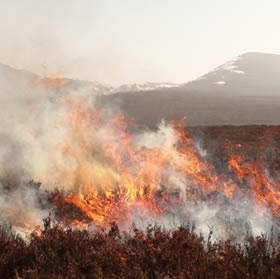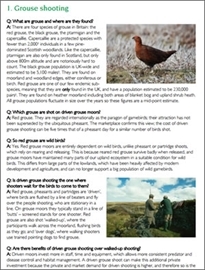 By Andrew Gilruth, GWCT Communications Director
By Andrew Gilruth, GWCT Communications Director
Earlier this year The Times used the headline 'RSPB ‘twisted data’ in campaign against grouse shooting' after we reported here that an international group of scientists published their concerns that some UK organisations were misrepresenting evidence for the damaging effects of fire in moorland management.
They suggested much of this contextualisation of issues, such as burning, stemmed less from the evidence of the environmental effects and more from attitudes towards patterns of land ownership1.
The response?
1) The RSPB responded here. It acknowledged, in a subsequent paper of response submitted to the Royal Society, that it was wrong to claim “and the damage it can cause” in relation to heather burning. This claim “exceeded the research findings”2.
2) Without more information the ‘precautionary principle’ should be applied (so stop burning until you understand all the impacts).
Did the international group of scientists stand their ground?
Yes. The original group of authors (from the UK, the Netherlands, Italy, Portugal, Norway and the USA) responded once more in the same Royal Society journal3. They rejected the precautionary principle approach because “given existing uncertainty there is no guarantee that such changes will provide the desired benefits”.
Instead, they advocate what is widely considered to be the best available approach for managing biological systems in the presence of uncertainty: adaptive management4. Some might call this ‘continuous improvement’. This allows us to combine action today with learning for tomorrow.
Where does that leave us?
There remains contradictory evidence about the actual positive or negative impact of burning when longer timescales are taken into account5,6. More research is needed – much of it over the medium to long term. The following views are STILL NOT verified by the evidence currently available and should not be perpetuated in discussions until they are formally addressed1:
- regular burning increases heather dominance
- fire kills or significantly damages Sphagnum moss
- peatlands are particularly sensitive sites with regard to fire
- managed burning helps protect against wildfire
- fire alone can contribute to peatland degradation
Are these negative views of heather burning still being perpetuated?
Yes. The latest RSPB magazine rounds off an update on the restoration work its staff have undertaken at Dove Stone by saying: “This is in stark contrast to the unsustainable management of many of our internationally important bogs, which continue to be burned for grouse shooting.” You can read the piece here.
The authors form the University of Leeds have asked us to clarify that they were not defending the RSPB’s position in heather burning. We are delighted to do so. For the avoidance of doubt the reference to their paper in paragraph four was removed on 17/10/16.
Get your FREE guide to grouse shooting and moorland management
 What's inside your FREE guide
What's inside your FREE guide
✓ Grouse shooting
✓ Conservation on grouse moors
✓ Heather burning
✓ Moorland drainage
✓ Disease control
✓ Upland predator control
✓ Hen harriers and red grouse
✓ Mountain hares and red grouse
✓ Alternative moorland use
✓ Commonly heard criticisms of driven grouse shooting
Get your FREE guide to grouse shooting and moorland management >
References
1. Davies GM, Kettridge N, Stoof CR, Gray A, Ascoli D, Fernandes PM et al. The role of fire in UK peatland and moorland management: the need for informed, unbiased debate. Philos Trans R Soc London B Biol Sci 2016; 371.
2. Douglas DJT, Buchanan GM, Thompson P, Wilson JD. The role of fire in UK upland management: the need for informed challenge to conventional wisdoms: a comment on Davies et al. (2016). Philos Trans R Soc B Biol Sci 2016; 371: 20160433.
3. Davies GM, Kettridge N, Stoof CR, Gray A, Marrs R, Ascoli D et al. The peatland vegetation burning debate: keep scientific critique in perspective. A response to Brown et al. and Douglas et al. Philos Trans R Soc London B Biol Sci 2016; 371.
4. Westgate MJ, Likens GE, Lindenmayer DB. Adaptive management of biological systems: A review. Biol Conserv 2013; 158: 128–139.
5. Brown L, Holden J, Palmer S. Effects of moorland burning on the ecohydrology of river basins. Key findings from the EMBER project. 2014.
6. Clay GD, Worrall F, Aebischer NJ. Carbon stocks and carbon fluxes from a 10-year prescribed burning chronosequence on a UK blanket peat. Soil Use Manag 2015; 31: 39–51.